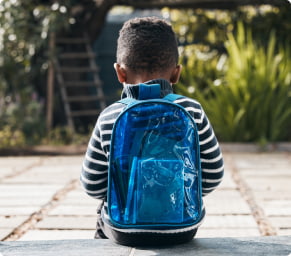Understanding Bullying in Special Needs Children
 The impact of bullying on children with disabilities can be devastating, affecting those with a range of conditions, such as autism, cerebral palsy (CP), and attention-deficit/hyperactivity disorder (ADHD).
The impact of bullying on children with disabilities can be devastating, affecting those with a range of conditions, such as autism, cerebral palsy (CP), and attention-deficit/hyperactivity disorder (ADHD).
Children with disabilities, including physical, developmental, emotional, intellectual, and sensory disabilities, face an increased risk of being bullied due to various factors, like physical vulnerability and social skill challenges.
Recognizing the signs of bullying early is essential. By focusing on prevention strategies and fostering a culture of inclusivity and empathy, parents, educators, and caregivers can work to stop bullying before it starts.
5 Types of Bullying
Bullying can involve many forms of harm, but generally, there are 5 types. By understanding these different forms of intimidation, parents, caregivers, and educators are better able to spot and stop bullying.
1. Physical Bullying
Physical bullying involves hitting, pushing, or other forms of physical harm. This type of bullying poses a significant risk for children with special needs, who might struggle more with self-defense and communicating their experiences.
Careful supervision and fostering an atmosphere of kindness are key steps in protecting vulnerable children and preventing acts of aggression.
2. Verbal Bullying
Verbal bullying includes teasing, name-calling, and threats, impacting children with special needs by harming their self-esteem and emotional well-being.
Creating a supportive environment where respectful communication is the norm can help shield children from the effects of verbal abuse.
3. Cyberbullying
Cyberbullying involves harassment and bullying through digital platforms. For children with special needs, it can be particularly damaging as it invades safe spaces and can feel unending.
Educating children on internet safety and fostering open communication are key steps in protecting them from cyberbullying’s harmful impact.
4. Social Alienation
Social alienation occurs when children are deliberately excluded from group activities and friendships. For children with special needs, this exclusion can deepen feelings of isolation and affect their social development.
Promoting inclusive activities and teaching empathy to all children is essential to combat social alienation.
5. Property Damage
Property damage involves the intentional destruction or harm to a child’s possessions. This could involve tampering with their adaptive equipment.
For children with special needs, this can be particularly distressing, as some may rely on specific tools or items for comfort and support.
Addressing these incidents promptly and demanding respect for the personal belongings of all children are key steps in preventing property damage.
Recognizing Bullying in Children with Special Needs
Identifying bullying in children with special needs requires careful observation, as they may not always communicate their experiences directly.
It’s crucial for parents and educators to maintain open lines of communication and to create a supportive environment where children feel safe to share their feelings and experiences.
Signs of Bullying in Children
Signs of bullying in children can show up in various ways, impacting their behavior and academic performance. Parents and educators should be on the lookout for behavioral changes.
- Aggression or anger that is not typical for the child
- Changes in eating or sleeping patterns
- Increased withdrawal from social interactions or activities they once enjoyed
- Lack of interest in schoolwork or reluctance to go to school
- Noticeable drop in grades
- Signs of anxiety or depression
Identifying these signs early allows caregivers to intervene promptly. Effective intervention strategies often begin with open communication.
Spotting Bullying in Nonverbal Children
Identifying bullying in children with disabilities presents unique challenges, especially when they are nonverbal or have communication difficulties.
Children with special needs might not be able to express their feelings or recount incidents verbally, making it harder for parents, caregivers, and educators to recognize when bullying is occurring. Observing changes in behavior or emotional state becomes crucial.
- Agitation or restlessness
- Avoidance of certain places or people
- Changes in mood or behavior
- Decreased interest in activities they once enjoyed
- Increased signs of anxiety or distress
- Reluctance to go to school or participate in usual activities
- Sudden changes in eating or sleeping patterns
- Unexplained injuries or marks
It’s essential for those involved in caring for children with special needs to understand the nuances of nonverbal communication and foster a supportive environment where children feel safe and protected.
Creating alternative communication strategies, such as using pictures, gestures, or technology, can provide children with a means to express themselves and share their experiences.
Special Needs and Vulnerability
Children with special needs often face unique vulnerabilities that can make them targets for bullying. Their differences, whether visible or invisible, may be misunderstood or exploited by others.
These vulnerabilities can stem from physical disabilities, learning difficulties, or social communication challenges, making it harder for them to defend themselves or seek help.
Recognizing these vulnerabilities is the first step toward protecting them and ensuring they receive the support they need.
Understanding the Increased Risks
Children with special needs are at an increased risk of being bullied due to factors like misunderstanding from their peers, communication barriers, or physical differences.
They might struggle with social cues, making them more susceptible to manipulation or aggression. Additionally, their need for assistance or accommodations can sometimes isolate them from their peers, further increasing their risk of becoming targets for bullying.
- Autism
- Birth injuries
- Epilepsy (seizure disorder)
- Food allergies
- Juvenile diabetes
- Speech delays
Bullying related to a health condition may lead to risky behaviors, like the child avoiding necessary medications or treatments.
Social Skills and Bullying
Social skills play a crucial role in navigating interpersonal relationships and can significantly impact a child’s likelihood of being bullied.
Children with special needs often face challenges in developing these skills, making it difficult for them to recognize bullying behaviors or advocate for themselves.
Teaching social skills and creating environments that foster inclusive interactions can help reduce bullying incidents by promoting understanding and empathy among all students.
The Role of Educational Settings
Educational settings are pivotal in preventing and addressing bullying, especially for children with special needs.
Schools can implement policies and programs that promote inclusion, educate students about diversity and empathy, and provide clear protocols for reporting and addressing bullying.
Staff training on the unique needs of students with disabilities and the creation of a supportive school culture are also vital in ensuring a safe learning environment for every child.
Understanding the Impact of Bullying
The impact of bullying on the mental health of children with special needs cannot be understated. Experiencing bullying can lead to anxiety, depression, low self-esteem, and trauma, exacerbating any pre-existing conditions.
“Bullying can result in physical injury, social and emotional distress, self-harm, and even death.”
It is essential for parents, educators, and professionals to recognize the signs of mental distress and provide appropriate support and interventions.
Creating a network of support around children with special needs can help reduce the negative effects of bullying and promote resilience and well-being.
3 Strategies for Bullying Prevention and Intervention
Implementing effective strategies for the prevention and intervention of bullying is essential, especially for children with special needs. Learn more about strategies to face bullying head-on below.
1. Creating a Safe and Inclusive Environment
Creating a safe and inclusive environment is fundamental to preventing bullying. This involves fostering a school culture that values diversity, inclusivity, and mutual respect.
Schools should ensure that all students, especially those with special needs, feel valued and included in all aspects of school life.
- Clear anti-bullying policies
- Regular monitoring of student interactions
- Safe spaces for students to express concerns
2. Developing Social Skills and Resilience
Teaching children — especially those with special needs — social skills and resilience is a proactive way to reduce their vulnerability to bullying.
Programs that focus on social skill development, empathy, self-advocacy, and conflict resolution can equip children with the tools they need to navigate social interactions positively.
Encouraging resilience helps them to recover from negative experiences and fosters a sense of self-worth and confidence.
3. Educational Programs for Students and Staff
Educational programs designed to teach students and staff about the importance of empathy, respect, and the impact of bullying are critical.
Training sessions for staff on the specific challenges faced by students with special needs and how to address them can lead to a more understanding and supportive environment.
Peer education programs can also empower students to stand up against bullying and support their classmates.
Legal Protections for Students with Disabilities
Children with special needs are protected under various federal laws to ensure they receive the same educational opportunities as their peers and are safeguarded from discriminatory practices, including bullying.
All 50 states have anti-bullying legislation. And federally-funded schools are obligated to address bullying based on protected characteristics, including disability, under various civil rights laws.
The Individuals with Disabilities Education Act (IDEA) ensures students with disabilities have access to a free, appropriate public education in the least restrictive environment.
Section 504 of the Rehabilitation Act of 1973 prohibits discrimination based on disability in programs that receive federal financial assistance, including public schools.
The Americans with Disabilities Act (ADA) further protects individuals from discrimination based on disability in all areas of public life.
Schools are required to address bullying that affects a child’s education, especially if the bullying is based on the child’s disability.
If you suspect bullying, promptly contact school officials to ensure your child’s rights are protected under applicable laws.
Support Systems and Resources
Providing strong support systems, including counseling and support groups, can offer significant help. Empowering children with special needs and their peers to stand against bullying creates a culture of respect and safety.
Learn more about support systems and resources below.
Counseling and Therapy
 Counseling and therapy can be vital for children with special needs who experience bullying, offering them a safe space to express their feelings and develop coping strategies.
Counseling and therapy can be vital for children with special needs who experience bullying, offering them a safe space to express their feelings and develop coping strategies.
Therapists who specialize in working with children with disabilities can provide tailored support, helping to build self-esteem, resilience, and social skills.
Family therapy can also help family members understand the child’s experiences and learn how to provide effective support at home.
If you’re looking for a therapist, a good way to begin your search is by asking your child’s pediatrician for a recommendation or referral.
Support Groups for Children and Parents
Support groups for families with special needs can provide a community of understanding and empathy where individuals can share experiences, strategies, and encouragement.
These groups can be a source of valuable information and emotional support, helping to reduce feelings of isolation and empowering children and families to navigate the challenges of bullying.
Online Resources and Helplines
Numerous online resources and helplines are available to provide immediate support and information for children with special needs and their families facing bullying.
These resources can offer advice, legal information, coping strategies, and connections to local support and intervention services.
Ensuring that children and parents are aware of these resources is an important step in providing accessible assistance.
Educational Materials and Workshops
Educational materials and workshops can equip children with special needs, their families, and educators with knowledge and skills to prevent and address bullying.
Workshops can focus on building empathy, understanding disabilities, developing social skills, and creating inclusive environments.
Educational materials, such as guides, videos, and lesson plans, can be valuable tools in fostering a supportive and informed community.
Fostering a Bully-Free Environment for All Students
To foster a bully-free environment, it is essential to create a culture of respect, inclusivity, and kindness within educational settings and the larger community.
- Encouraging student leadership in promoting a positive school climate
- Implementing policies and programs that adopt zero-tolerance approaches
- Involving all members of the school community in anti-bullying efforts
- Modeling positive behavior in teachers and administrators
Parents and guardians play a crucial role in preventing and addressing bullying. They should work to maintain open lines of communication with their children and the school staff, actively participate in school activities, and educate themselves on the signs of bullying.
Empowering parents with strategies to support their children’s social and emotional development at home complements the efforts made by schools.
Bullying in Special Needs Children FAQs
What does bullying look like for children with special needs?
Bullying for children with special needs might include aggressive behaviors like teasing, physical harm, and exclusion.
It can also show up in ways that exploit particular vulnerabilities, like taking advantage of communication difficulties in children with cerebral palsy or tampering with their assistive devices.
How can parents and educators spot signs of bullying?
Parents and educators can spot signs of bullying by observing changes in the child’s behavior, emotional state, or academic performance.
Unexplained injuries, reluctance to go to school, changes in mood, and regression in skills can all be indicators of bullying.
What are effective ways to prevent bullying of children with special needs?
Strategies to prevent bullying should focus on creating a supportive community that understands the value of diversity and the importance of treating everyone with respect.
Strategies to counter bullying in special needs kids include:
- Educating students and staff about disabilities and empathy
- Fostering an inclusive and respectful school culture
- Implementing strong anti-bullying policies
- Providing ample support and resources for students with special needs
How should schools and parents respond to bullying incidents?
Schools and parents should respond to bullying incidents by taking them seriously, providing support to the victim, investigating the incidents thoroughly, and implementing appropriate consequences for the perpetrators.
Ongoing communication between parents, educators, and the child is crucial to creating a supportive environment for recovery and well-being.



